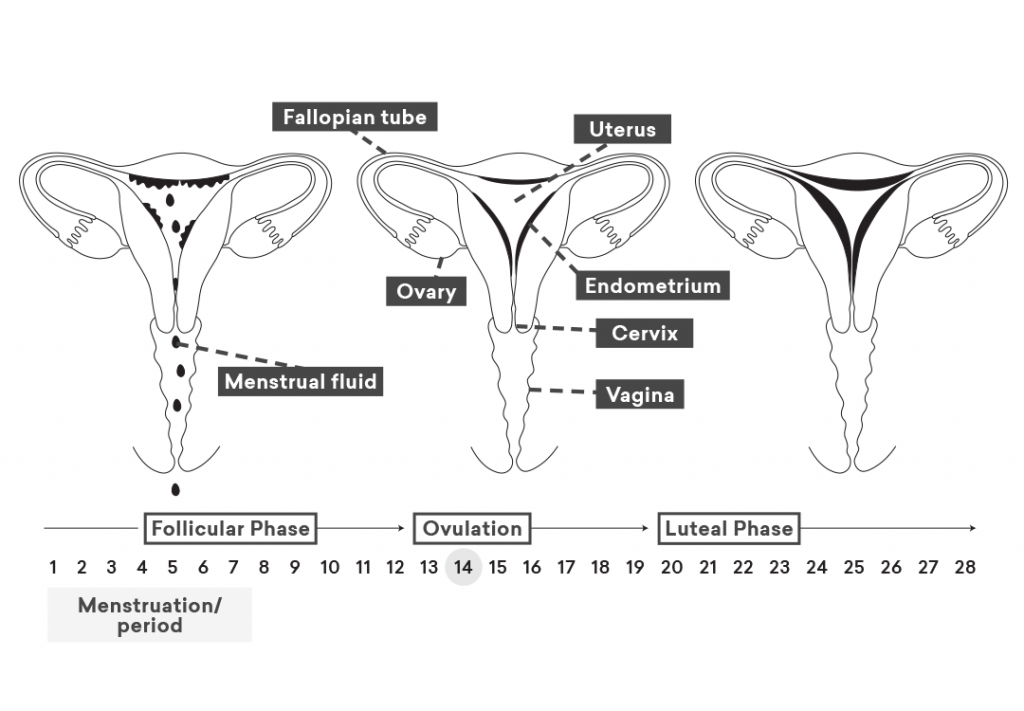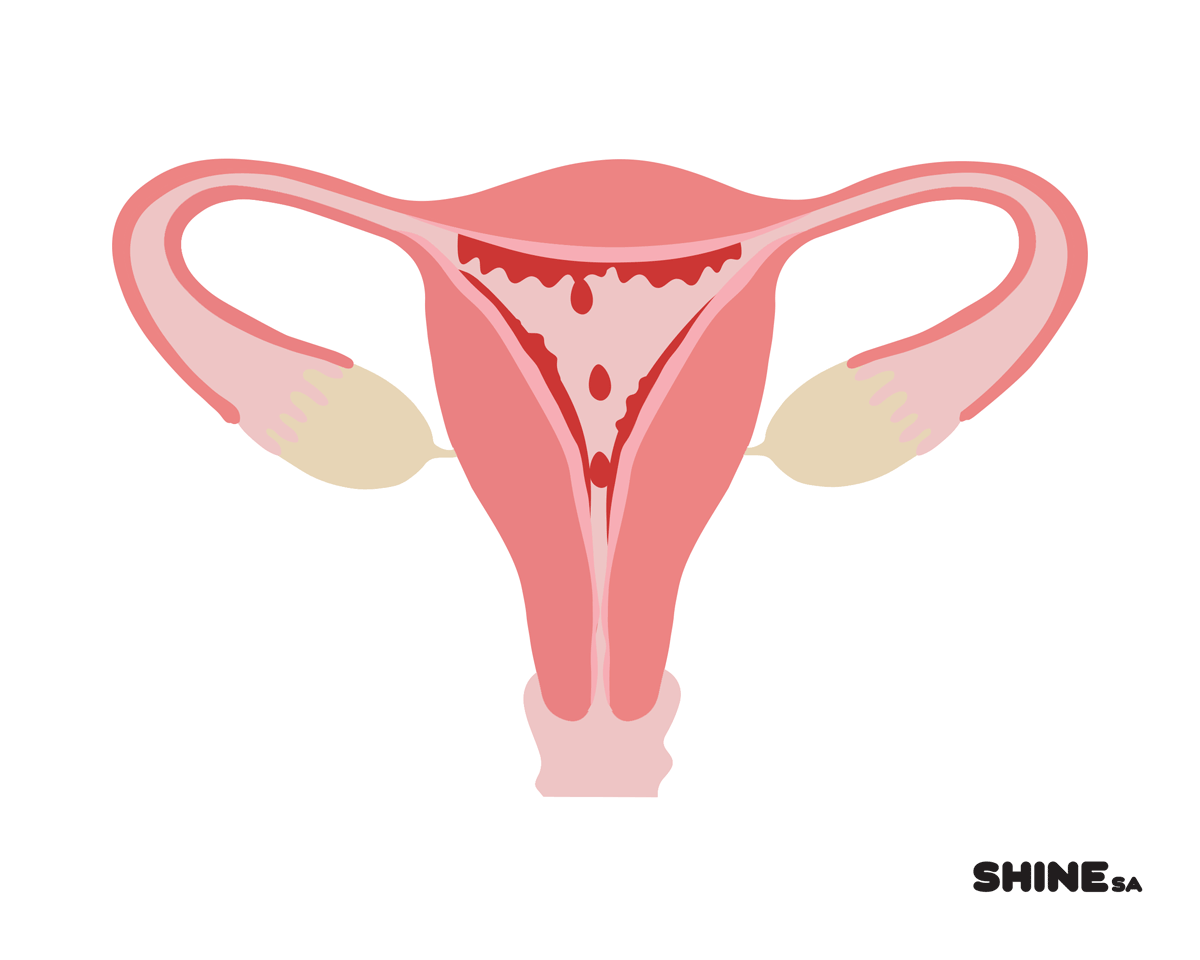What is the menstrual cycle?
The menstrual cycle is a hormonal and physical cycle that the body goes through in preparation for pregnancy – often occuring monthly. The menstrual cycle usually starts between the ages of 8 to 16. The beginning of the menstrual cycle often occurs after other sexual characteristics have developed, such as breasts and pubic hair. Menstrual cycles continue until menopause, which usually occurs between the ages of 45-55.
What are the phases of the menstrual cycle?
The phases of the menstrual cycle consists of period/menstruation, follicular phase, ovulation and luteal phase.

Period/Menstruation
A period or menstruation is the shedding of the lining of the uterus (womb) in response to hormonal changes. Menstrual fluid contains blood and cells from the endometrium (lining of the uterus).
Generally, the bleeding during a period lasts for 2-7 days but can vary.
Menstruation can also vary in colour and consistency. Periods are usually heavier over the first day or two than they are towards the end.

Follicular Phase
The follicular phase starts on the first day of menstruation and ends with ovulation. Following a period, two main things happen over the next two weeks: usually one egg will mature and be released and the lining of the uterus thickens in preparation for a possible pregnancy.
Ovulation
Ovulation occurs around 2 weeks before the end of a menstrual cycle (generally mid-cycle, but this can vary). Ovulation is when a mature egg is released from an ovary and travels through the fallopian tube to the uterus. Once an egg is released, it survives for 12-24 hours. This is when an egg can be fertilised if sperm is present.
Sperm could be present if the person has had unprotected vaginal intercourse with someone with a penis in the previous 5-7 days. If the egg is fertilised and implants into the uterus, then a pregnancy develops and the menstrual cycle will usually stop for the time being.
Luteal Phase
The luteal phase is where the body prepares for pregnancy. The endometrium thickens making the body prepared for a fertilised egg to implant. If pregnancy doesn’t happen the lining of the uterus will shed, causing a period.
What is a healthy menstrual cycle?
When it comes to menstrual cycles there is a wide range of what is healthy. Typically, a menstrual cycle lasts from 21 to 35 days although it can be shorter or longer (the length of a menstrual cycle is measured from the first day of one period to the first day of the next period).
Some people have very consistent menstrual cycles, whilst others will notice variation in the length of their cycles or periods.
Periods lasting more than 7 days or needing more than 6 tampons/pads per day can be considered heavy bleeding. It can also be normal to skip periods at times. Periods can stop due to low body weight, stress, intense exercise, contraception and other factors.
The best way to know what’s normal for you is to record your menstrual cycle and see what happens month to month. Whilst it may take a year or two for your menstrual cycle to settle into a pattern, knowing your own ‘normal’ helps you to identify when something changes.
If you are concerned about your cycle, speak to a GP or visit SHINE SA.
What happens to cervical mucus/vaginal discharge during the cycle?
Throughout the cycle, the cervix produces mucus, often called discharge. Discharge is fluid produced by glands in the vagina. It helps keep the vagina lubricated and removes bacteria keeping the vagina healthy. It can be clear to milky white.This substance changes in colour and texture throughout the cycle. Around the time of ovulation, cervical mucus/discharge is likely to be clear and stretchy or clear and watery. Vaginal discharge/cervical mucus is normal and healthy. It does not indicate sexual thoughts or activity. Some people will produce large amounts whilst others may not notice any.
If you notice a new change in colour, smell or quantity compared to what is normal for you, this could indicate an infection and you should see a doctor.
What is PMS (Pre-Menstrual Syndrome)?
Many people who have periods experience pre-menstrual syndrome (PMS). PMS refers to symptoms that appear in the days leading up to a period. Symptoms can be physical (e.g. sore breasts, cramping, diarrhoea, tiredness, headaches) or emotional (e.g. anxiety, irritability, sadness). Some people have a severe form of PMS called Premenstrual Dysphoric Disorder (PMDD) which requires treatment. If you are experiencing severe mood swings in the 1-2 weeks leading up to and the first few days of your period, or you are concerned about your experience see a doctor to dicsuss treatment options.
How can I manage pain during periods?
Mild to moderate pain can be a normal part of periods. As the endometrium is shed, the uterus contracts to help expel the period. These contractions are a milder version of what occurs during labour and are known as menstrual cramps or period pain.
There are many options for managing menstrual cramps, including pain medication (e.g. ibuprofen), heat packs and exercise.
If pain is severe, lasts beyond the first few days of your period, does not lessen with pain or hormonal medication or is significantly affecting your daily life, you should see a GP for advice. It is not normal to have to miss school or work on a regular basis due to period pain, this pain can be managed with medical advice.
How can hormonal contraception help manage periods?
Some people find hormonal contraception to be a useful way of managing their menstrual cycle. Hormonal contraception is a method used to prevent pregnancy. For some people these medications can be used to reduce/stop periods, reduce period pain, improve acne and body hair, reduce PMS symptoms and give the ability to control the timing of periods. It is important to speak to a GP or SHINE SA to see what the best option may be for you.
What menstrual products are available?
There are a variety of products available to manage periods. You can make decisions about what to use based on comfort, cost, accessibility and practicality.
External products
- Disposable or reusable pads
Pads are attached to underwear to absorb menstrual fluid. Pads should be changed when they look or feel full. Disposable pads need to be wrapped and placed in a bin whilst reusable pads are rinsed and then washed in a washing machine. - Period underwear
Period underwear is an increasingly popular option. There are many styles and shapes available. Period underwear is changed when needed and then washed for reuse. Some kinds can be worn when swimming.
Internal products
- Tampons
These are a disposable product inserted into the vagina to absorb menstrual blood. There are many different absorbencies available. Tampons are changed when full or at least every 8 hours. Used tampons should be wrapped and placed in a bin, not flushed. Tampons can be used when swimming. - Menstrual cups
Made of silicone, a menstrual cup is folded and inserted into the vagina where it then unfolds. A menstrual cup is removed to empty menstrual fluid when needed, then can be washed and reused. Menstrual cups can be used when swimming.
Further information
You can find more information on conditions associated with the menstrual cycle at the following websites:
- SHINE SA www.shinesa.org.au/endometriosis
- Pelvic Pain Foundation of Australia
www.pelvicpain.org.au/period-pain - Jean Hailes www.jeanhailes.org.au






